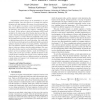51 search results - page 6 / 11 » Identifying Protein Flexibility by NMA |
ICCAD
2009
IEEE
13 years 4 months ago
2009
IEEE
Computational protein design can be formulated as an optimization problem, where the objective is to identify the sequence of amino acids that minimizes the energy of a given prot...
BMCBI
2006
13 years 7 months ago
2006
Background: Statistical methods for identifying positively selected sites in protein coding regions are one of the most commonly used tools in evolutionary bioinformatics. However...
BMCBI
2008
13 years 7 months ago
2008
teps. First, we abstracted protein interactions onto orthologous cluster links. For a given source interaction, if both proteins belonged to a cluster, we constructed a link betwee...
BMCBI
2007
13 years 7 months ago
2007
Background: Matching functional sites is a key problem for the understanding of protein function and evolution. The commonly used graph theoretic approach, and other related appro...
BMCBI
2008
13 years 7 months ago
2008
Background: A multiple sequence alignment (MSA) generated for a protein can be used to characterise residues by means of a statistical analysis of single columns. In addition to t...

